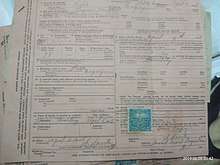Death certificate
The phrase death certificate can refer either to a document issued by a medical practitioner certifying the deceased state of a person or, popularly, to a document issued by a person such as a registrar of vital statistics that declares the date, location and cause of a person's death as later entered in an official register of deaths.
_death_certificate.gif)
Nature of a certificate

Before issuing a death certificate, the authorities usually require a certificate from a physician or coroner to validate the cause of death and the identity of the deceased. In cases where it is not completely clear that a person is dead (usually because their body is being sustained by life support), a neurologist is often called in to verify brain death and to fill out the appropriate documentation. The failure of a physician to immediately submit the required form to the government (to trigger issuance of the death certificate) is often both a crime and cause for loss of one's license to practice. This is because of past scandals in which dead people continued to receive public benefits or voted in elections.[1]
A full explanation of the cause of death includes any other diseases and disorders the person had at the time of death, even though they did not directly cause the death.[2]
Public documents
In most of the United States, death certificates are considered public domain documents and can therefore be obtained for any individual regardless of the requester's relationship to the deceased. Other jurisdictions take a different view, and restrict the issue of certificates. For example, in the State of New York, death certificates are only obtainable by close relatives, including the spouse, parent, child or sibling of the deceased, and other persons who have a documented lawful right or claim, documented medical need, or a New York State Court Order.[3]
History
In Europe and North America, death records were kept by the local churches, along with baptism and marriage records. In what would become the United States, the Massachusetts Bay Colony was the first to have the secular courts keep these records, in 1639. By the end of the 19th century, European countries were pursuing centralized systems for recording deaths.[2]
In the United States, a standard model death certificate was developed around 1910.[2]
Specific jurisdictions
Scotland
National registration began in 1855; registrations are rather more detailed.[4]
Stillbirths
United States
A 2007 article in People magazine revealed that in the case of a stillbirth it is not standard practice to issue both a birth certificate and a death certificate. Most states instead issue a "certificate of birth resulting in stillbirth".[5]
See also
- Birth certificate
- Ghosting (identity theft)
- Marriage licence
- Marriage certificate
- Mortality Medical Data System (MMDS)
References
- "Dead People Voting Throughout Florida". WFTV Orlando. VOLUSIA COUNTY, Fla. 30 Oct 2008. Archived from the original on 23 May 2011. Retrieved 26 December 2010.
- Altman, Lawrence K. (1 July 2013). "Making the Right Call, Even in Death". The New York Times. Retrieved 7 July 2013.
- "Death Certificates". New York State Department of Health.
- "Items Included in the Main Registers". General Register Office for Scotland. Archived from the original on 8 June 2012. Retrieved 14 August 2012.
- "Welcome to MISSing Angels Bill". www.missingangelsbill.org. Retrieved 22 March 2018.
External links
| Wikimedia Commons has media related to Death certificates. |
- Mortality Data from the U.S. National Vital Statistics System - See Methods - Data collection - for copies of death certificates and how to fill them.
- Magrane BP, Gilliland MGF, and King DE. Certification of Death by Family Physicians. American Family Physician 1997 Oct 1;56(5):1433-8. PMID 9337765
- Swain GR, Ward GK, Hartlaub PP. Death certificates: Let's get it right. American Family Physician February 15, 2005 PMID 15742904
- Find Free Death Records gives details on how to apply for death records in each state.
- Online Death Indexes and Records lists some online death certificate indexes
- Where to Write for Vital Records (including Death Certificates) from the National Center for Health Statistics